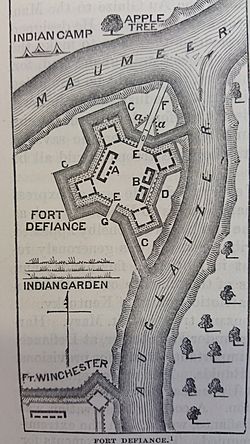Fort Defiance (Ohio) facts for kids
Quick facts for kids Fort Defiance |
|
|---|---|
| Part of the Northwest Territory of the United States | |
| present day Defiance, Ohio | |

Fort Defiance
|
|
| Site history | |
| Built | 1794 |
| Battles/wars | Northwest Indian War, Tecumseh's War, War of 1812 |
| Garrison information | |
| Past commanders |
Anthony Wayne |
| Occupants | United States troops |
|
Fort Defiance Park
|
|

|
|
| Location | Fort St., Defiance, Ohio |
|---|---|
| Area | 1.3 acres (0.53 ha) |
| Built | 1794 |
| Architect | Major Henry Burbeck |
| NRHP reference No. | 80002989 |
| Added to NRHP | June 23, 1980 |
Fort Defiance was an important military fort built in 1794 in what is now Defiance, Ohio. It was constructed by General "Mad" Anthony Wayne during a time when the United States was expanding its territory. The fort was strategically placed where the Auglaize and Maumee rivers meet.
Building Fort Defiance
Work on Fort Defiance started on August 9, 1794. It was finished very quickly, by August 17 of the same year. The fort was built as part of a larger plan to protect American forces during the Northwest Indian War. This war led to a major battle called the Battle of Fallen Timbers on August 20, 1794.
The name "Fort Defiance" came from a bold statement by Charles Scott. He was a leader of Kentucky soldiers helping General Wayne. Scott declared, "I defy the English, Indians, and all the devils of hell to take it." This showed how strong and important the fort was considered at the time. It was one of the toughest forts built during that period.
Life at the Fort
Before and during the Battle of Fallen Timbers, General Wayne ordered the destruction of villages and crops belonging to local Native American communities. This was done to weaken their ability to fight. The land where these communities lived had been given to the United States by the British after the American Revolutionary War. However, the British continued to support and encourage local tribes to resist American settlement.
After the war, a peace agreement was made. This was the Treaty of Greenville, signed on August 3, 1795. As part of this treaty, Native American nations gave up a six-square-mile area around Fort Defiance. This allowed Americans to keep a trading post there. General Wayne also promised that the land to the west, known as "Indiana," would remain Native American territory forever. During the treaty talks, Wayne provided food for the Native Americans and helped them replant their crops. Fort Defiance was no longer needed for military purposes and was abandoned in 1796.
Fort Defiance's Legacy
Fort Defiance played a role in later history too. In 1807, it was used as a key point to draw a boundary line in the Treaty of Detroit. This north-south line later became known as the Michigan Meridian. It was used to survey and map lands in Michigan.
In 1812, during the War of 1812, a new fort called Fort Winchester was built nearby by General William Henry Harrison. This showed the continued importance of the area.
The city of Defiance, Ohio, was founded in 1822 at the exact spot where the fort once stood. In 1904, the site of the old fort was chosen as the location for the Defiance Public Library.
Today, a park stands where Fort Defiance used to be. This park was added to the National Register of Historic Places in 1980. It helps us remember the fort's important role in American history.




